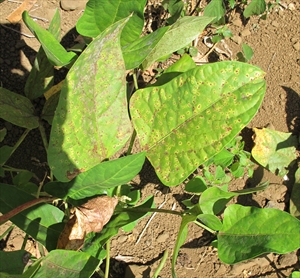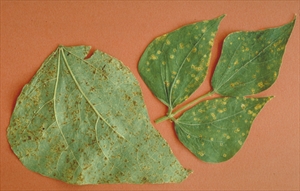Bean rust (Phaseolus species).
Pacific Pests, Pathogens and Weeds - Online edition
Pacific Pests, Pathogens & Weeds
Bean Phaseolus rust (217)
Uromyces appendiculatus var. appendiculatus. Previously Uromyces phaseoli.
Asia, Africa, North, South and Central America, the Caribbean, Europe, Oceania. It is recorded from American Samoa, Australia, Fiji, Guam, New Caledonia, New Zealand, Papua New Guinea, and Solomon Islands. However, according to the check list for Solomon Islands, it is probable that the two records of Uromyces appendicatus on cowpea are misidentifications of Uromyces vignae1.
Mainly on beans, Phaseolus species. Another rust, Uromyces vignae occurs on Vigna species (Vigna marina and Vigna unguiculata ssp. sesquipedalis). This rust occurs widely, and is present in Fiji, Samoa, Solomon Island, and Tonga.
Circular pustules, 1-2 mm diameter, light green with distinctive yellow haloes on the top surface, scattered over both sides of the leaves, and on the pods (Photos 1&2). Later, the pustules rupture producing reddish-brown powdery spore masses.
The rust has all five spore stages, and completes its life cycle on Phaseolus species. This is in contrast to other rust species that have fewer life stages, and others that may have all stages, but more than one host.
Spread is by spores blown in the wind. Some spore types are specially adapted for survival and have thick dark walls; they can survive a long time in the atmosphere, travelling great distances. The hardiness of the spores increases the chance infection of bean crops. In the tropics, new bean crops often overlap old ones, so that survival of rust is more easily assured
The rust causes a destructive disease of beans. Loss in yield are reported from many countries; not only do the losses depend on the environment - the rust favours relatively cool, damp weather with heavy dews - but also on variety as there are differences in susceptibility.
Look for reddish-brown circular pustules with yellow halos, producing masses of spores on leaves and pods. Expert examination is necessary to distinguish between Uromyces appendiculatus and Uromyces vignae.
CULTURAL CONROL
There are several ways to reduce the impact of rust on Phaseolus beans, apart from using fungicides:
During growth:
- Plant beans with maize as a mixed intercrop. A 'mixed intercrop' is one where the crops are planted at random, not in rows.
After harvest:
- Collect and burn or bury as much of the crop as possible.
- Do not plant one crop of beans after another in the same land; use a rotation of at least 2-years.
- Do not plant another crop of beans while the last crop is still in the ground, otherwise the rust will easily spread from the old crop to the younger one.
RESISTANT VARIETIES
There are a number of varieties with resistance to bean rust; contact agriculture authorities or seed suppliers to see if any are available in your area.
CHEMICAL CONTROL
If fungicides are needed, use mancozeb. Start to spray when symptoms first appear.
____________________
When using a pesticide, always wear protective clothing and follow the instructions on the product label, such as dosage, timing of application, and pre-harvest interval. Recommendations will vary with the crop and system of cultivation. Expert advice on the most appropriate pesticides to use should always be sought from local agricultural authorities.
AUTHOR Grahame Jackson
Information from Diseases of vegetable crops in Australia (2010). Editors, Denis Persley, et al. CSIRO Publishing; and Liberato JR, Sartorato A (2005) Bean Leaf Rust (Uromyces appendiculatus var. appendiculatus ): PaDIL - http://www.padil.gov.au; and CABI (2019) Uromyces appendiculatus (bean rust). Crop Protection Compendium. (https://www.cabi.org/cpc/datasheet/55816); 1McKenzie E, Jackson G (1986) The fungi, bacteria and pathogenic algae of Solomon Islands. Field Document 11, RAS/83/001. Food and Agriculture Organization of the United Nations in association with the South Pacific Commission. Photo 1 Kohler F, et al. (1997) Diseases of cultivated crops in Pacific Island countries. South Pacific Commission. Pirie Printers Pty Limited, Canberra, Australia.
Produced with support from the Australian Centre for International Agricultural Research under project PC/2010/090: Strengthening integrated crop management research in the Pacific Islands in support of sustainable intensification of high-value crop production, implemented by the University of Queensland and the Secretariat of the Pacific Community.





